Birds
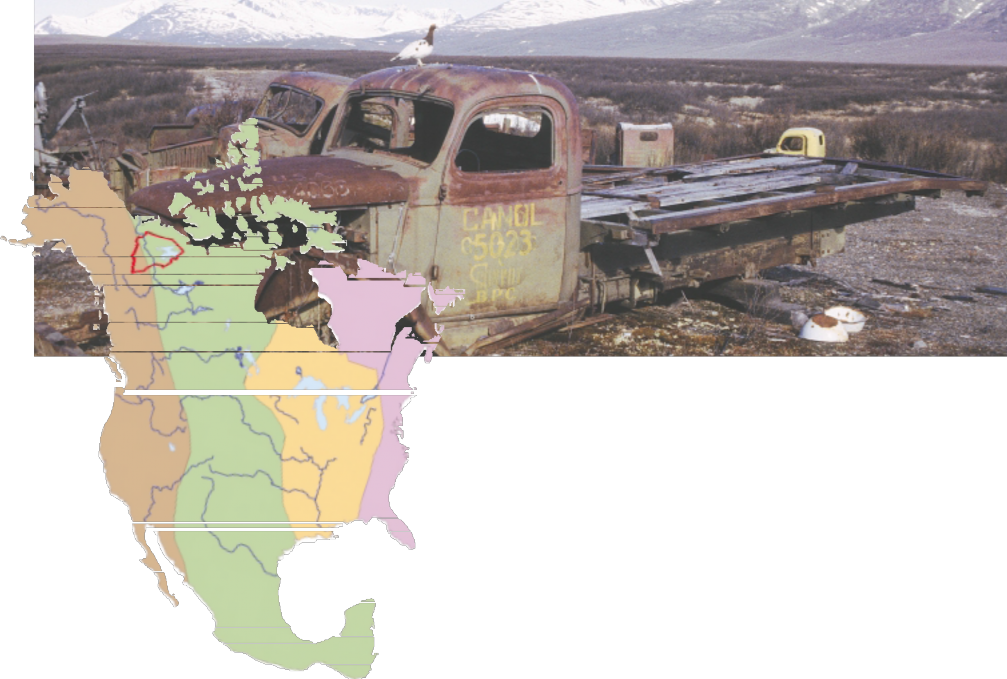
Birds of the Sahtu
There are four major North American flyways: Atlantic, Mississippi, Central and Pacific Flyways. The Sahtu straddles both the Pacific and Central flyways.
Bird migration is usually thought of as a north-and-south movement, with the lanes of heavier concentration following the coasts, mountain ranges and principal river valleys. Generally, the great routes of migration do conform very closely to major topographical features when these happen to lie in the general direction of the travel to be performed. It happens to work out nicely in North America where the coasts, mountain chains and many of the larger rivers do not depart from a northand- south alignment. As a result, birds use the Mackenzie Valley, River and Mountains to navigate their way north and south.
Over 90 percent of the bird species in the Sahtu and throughout the Nothwest Territories are migratory. In all, 41 families and over 200 species of bird spend time in the Sahtu.
The Sahtu also acts as a "production line" for numerous species. The abundant lakes, ponds and wetlands in the forested portion of the Northwest Territories provide important breeding and nesting habitat for a number of duck species and for other aquatic birds such as geese, loons and grebes.
The Sahtu also contains northern breeding range for species of song birds .
The terms "migration route" and "flyway" are to some extent theoretical concepts. Migration routes may be defined as the lanes of individual travel from any particular breeding ground to the winter quarters of the birds that use them. Flyways, on the other hand, may well be conceived as those broader areas in which related migration routes are associated or blended in a definite geographic region. They are wide arterial highways to which the routes are tributary.
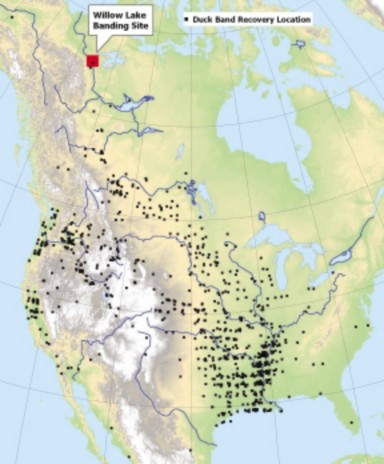
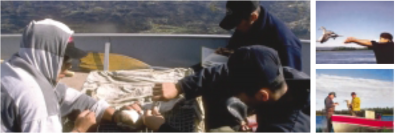
Since 1995, The Tulita Renewable Resources Council, the Government of the Northwest Territories' Department of Resources, Wildlife and Economic Development, and the United States Fish and Wildlife Service have collaborated on a duck banding research project at Willow Lake in Sahtu Settlement Area. Each year, a waterfowl biologist, two assistants and two summer students set 18 funnel traps in August (for an equivalent of 423 trap-nights). Barley is used as bait, around 2300 kg (5000 lb). The primary goal for this site project is to band mallards northern pintail and all other ducks prior to the start of the fall hunting season.
In 1993, standard leg bands were placed on 1348 ducks: 435 American greenwinged teals, 312 American wigeons, 298 mallards, 296 northern pintails, 6 bluewinged teals and one American black duck. This total number of ducks banded is similar to the nine-year average for the Willow Lake banding station.
Some Key Sahtu Species
Arctic Tern
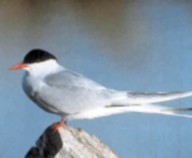
Terns are slender birds with long narrow wings, forked tails, and a pointed bill. The arctic tern (Sterna paradisaea) is grey and white with a black cap and red bill. Though it is primarily a sea bird, spending most of its life over the ocean and along the coast, it moves inland during the breeding season and may be found nesting virtually anywhere in the Northwest Territories, near open waters.
Terns are skillful and agile fliers, earning their living by diving into the water in search of small fish. They undertake spectacular migrations, leaving their breeding grounds in the north to fly to the Antarctic Ocean where they winter for a short time over the pack ice. As daylight hours in the Antarctic decrease, the terns start their return journey up the Atlantic and Pacific coasts following the sun as it returns north.
Canada Goose
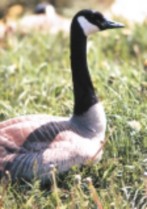
Although there are many subspecies that vary in size and colour, the Canada goose (Branta canadensis) is always readily identified by its black head, black neck and white cheek patch. It breeds throughout the mainland Northwest Territories as well as on some of the arctic islands.
Canada geese are the earliest of all waterfowl to nest. They arrive in the north while the land is still snow-covered and begin nesting as soon as the nest sites are clear. Although they prefer to nest on the ground near water, they employ a greater diversity of nest sites than all other waterfowl. These include marshes, tundra, islands, cliffs, abandoned nests in trees and tops of muskrat or beaver houses.
Gyrfalcon
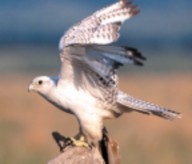
The gyrfalcon (Falco rusticolus), the Northwest Territories' ceremonial bird, is the world's largest falcon (50-63 cm tall). The colour of their plumage varies from dark grey throughout the mountains and southern tundra of the NWT to light grey or white in the east and on the Arctic islands.
Gyrfalcon's do not build nests.Eggs are laid and incubated by the female on a cliff ledges or, more usually, in the nests of other species such as ravens and golden eagles. Gyrfalcons nest in April in the Mackenzie Mountains and in May over the rest of their range. The same nesting ledge is frequently used in successive years.
Loons
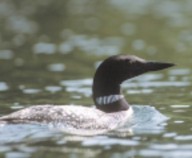
Loons are heavy-bodied birds with strong pointed bills, webbed feet, and short stiff tails. The legs are attached far back on the body, and while this makes loons awkward on land, it facilitates swimming and diving. Loons sit low in the water and dive from the surface. They can remain submerged for several minutes if necessary, and can swim very rapidly underwater. Loons are fish eaters, catching their prey while in underwater pursuit. When taking off, they must flap and run across the water's surface a lengthy distance before becoming airborne.
Four species occur in the Northwest Territories: the common loon (Gavia immer), the Arctic loon (Gavia arctica), the red-throated loon (Gavia stellata), and the yellowbilled loon (Gavia adamsii). The common loon is found throughout the Northwest Territories during the summer season, with the exception of the Arctic Islands. Both the yellow-billed and Arctic loon can be spotted above the tree-line during the summer season, while the red-throated loon can be found along the arctic coast throughout the summer months.
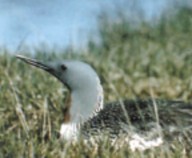
Peregrine Falcon
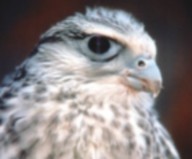
The peregrine falcon (Falco peregrinus) is one of the swiftest birds in the world, able to pursue its prey in high-speed aerial chases, reaching speeds close to 320 km-h in a downward dive. In the arctic, peregrines prey on birds varying in size from small songbirds to ducks and ptarmigan. The falcon swoops down on its prey at high speed and kills it in midair using bill and talons, or stuns it with a blow and kills it on the ground.
Peregrine falcons breed throughout most of the Northwest Territories on high rocky cliff ledges usually near the sea or some smaller body of water, habitat of its prey
Ptarmigan
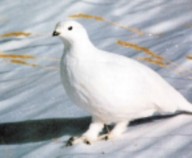
All three North American species of ptarmigan are found in the Sahtu: willow (Lagopus lagopus), white-tail (Lagopus leucurus) and rock ptarmigan (Lagopus mutus). Though the species are quite similar in appearance, the willow ptarmigan is a little larger and has a heavier bill. In summer, the brown of the willow ptarmigan is more reddish, while that of the Rock Ptarmigan is paler and more yellowish. In winter, both are white and have black tail feathers however the rock ptarmigan males have a black line through the eye.
As its name suggests, the rock ptarmigan frequents higher, more barren hills than the willow ptarmigan. In the winter, the willow ptarmigan seeks sheltered areas.
Ravens
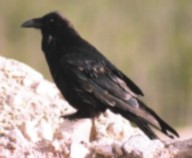
Ravens (Corvus corax) are the most commonly seen bird year-round in the Northwest Territories. They are large black birds with a thick bill, a shaggy ruff at the throat, and a wedge-shaped tail. In flight, they alternately flap and soar like a hawk.
Ravens are found in a variety of habitats, but are partial to cliffs and rocky mountainous country where they soar and perform acrobatics on the updrafts. They also congregate in settlements where tall buildings permit the same activities. Garbage dumps too are preferred spots as the raven is a scavenger and carrion-eater. Ravens are often seen in the company of wolves feeding on the remains of caribou on frozen lakes in winter.
Rough-legged Hawk
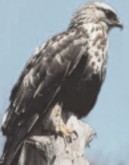
The rough-legged hawk (Buteo lagopus) is a large hawk (48-60 cm tall), it is a common summer inhabitant of the mountains and the tundra of mainland NWT and the southern Arctic archipelago. Winters are spent throughout the USA.
It is the only arctic hawk whose legs are completely feathered to the base of the toes. It has a broad tail and wings, and flying overhead can be identified by its distinctive black wrist patches. The adult plumage is variable in colours and marking but usually displays a dark patch or shield on the belly and a light tail with a distinct dark edge. A breeding pair builds a large stick nest on cliff ledges or on the ground, and may maintain several nests that are reused in subsequent years. Two or three eggs are laid in late May.
Sandhill Crane
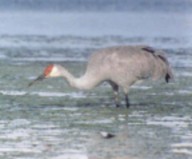
Sandhill cranes (Grus canadensis) are extremely large birds that are nearly a metre long, with a wingspan of up to 2 m. In flight, they can be identified by their outstretched neck, long trailing legs, and characteristic wing stroke (a quick jerk or flap of the wings upward). Adults are ash-coloured with a bare red patch on the forehead and crown. The voice is a deep incessant kr-r-r-oo, which sounds a bit like a piece of machinery in need of oil. Sandhill cranes may be found throughout most of the Northwest Territories, as far north as Banks Island.
Short-eared Owl
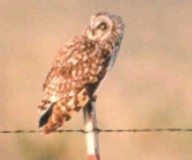
The short-eared owl (Asio flammeus) is a medium-sized owl with a brown back, and buffy-yellow head and breast, streaked with brown. Its ear-tufts are small and not usually visible. Unlike most owls, it is active throughout the day, cruising low, over open country, seeking out voles and lemmings. They are common during the breeding season in areas such as tundra, marshes, grasslands, and low scrub country. They breed throughout the mainland.
Lesser Sow Goose

The Lesser Snow Goose (Chen caerulescens caerulescens) has two colour phases, white and blue, and were once thought to be separate species. In the white form, adults are white with black wingtips. In the blue form, they are dark grey accompanied by a white head. They have wingspan of about 90 cm and its average weight is 2.2 to 2.7 kg, the male being larger. In the Sahtu, lesser snow geese breed entirely above the treeline.
Snowy Owl
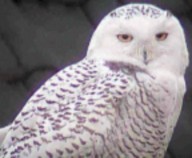
The heaviest of North American owls, the snowy owl (Nyctea scandiaca) stands nearly half a metre tall, with a wingspan of almost 1.5 m. Unlike most owls it is active in the day during the arctic summer, as well as at night. As is the case with most diurnal birds of prey—those that are active during the day—the female is larger and heavier than the male. The average weight of the female is 2.3 kg compared to 1.8 kg for the male. The feathers are sometimes pure white, but more generally they are barred and spotted with dark brown, particularly on the female. As an adaptation to its arctic environment, the snowy owl has completely feathered legs and toes. They usually nest above treeline.
Tundra Swan
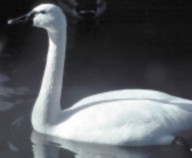
The tundra swan (Cygnus columbianus), formerly known as the whistling swan, is one of the largest birds found in the arctic. It has a wingspan of over 2 metres and a weight of 5-8 kg. It is completely white, with the exception of a slight rusty stain on the head and neck of some birds. The bill is black with bare skin extending back to the eye and sometimes a yellow or orange spot in front of the eye along with black legs.
Tundra swans generally arrive in the Northwest Territories by about mid May. They nest on the mainland above the treeline, as well as on some of the arctic islands and wetlands in the Sahtu.
Gray Jay
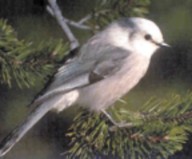
The gray jay (Perisoreus canadensis), 25 to 33 centimetres in length, is slightly larger than a robin. Its tail is long and its wings short and rounded. The throat, cheeks and breast, as well as an area round as a penny covering the forehead, are pearl grey. The back of the head is dark grey, the shoulders, back and tail lighter grey, sometimes with a bluish sheen. The legs are black, and light grey "whiskers" surround the base of the black bill.
The gray jay's fearless and venturesome behaviour towards men living and working in the forest has earned it many informal names. "Whiskey-Jack" is the best known, said to come from the mispronounciation of the native name "wisska- tjon" or "wis-ka-chon" turned into "whiskey-John".
[ Sahtu Atlas Table of Contents ]
[ Next Section ]
Wolverine, Fox, Lynx , Marten
Wolverine
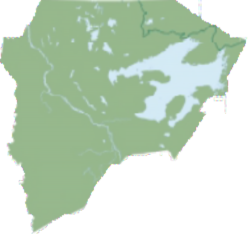
The wolverine (Gulo gulo) is the largest member of the mustelid family (otters, weasels, etc.) in North America. This squat, powerfully-muscled animal resembles a small, flattened bear. Wolverines are dark brown with a light grayish forehead and a pale stripe running from the shoulders along each side and crossing the rump. The wolverine's dense fur, with long guard hairs that do not ice up in winter, is highly prized for trimming parkas. Their large paws help them move on top of crusted snow. Awolverine has a dark bushy tail, a broad rounded head, small eyes and ears. Males average 1.2 meters in length and 0.5 meters in height at the shoulder. An average male weighs about 15 kilograms. Females are smaller, averaging about 0.9 metres in length and weighing about 10 kilograms.
Red Fox
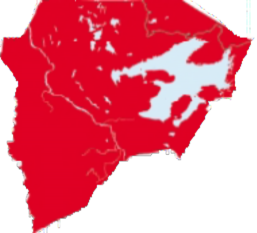
The red fox (Vulpes vulpes) ranges throughout the Sahtu below the treeline. The red fox is a small carnivore with an agile and lightly built frame. It is distinctive for its coat of long lustrous fur, and its relatively large and bushy brush (tail) and ruff (collar). A typical male fox weighs about 5 kg and stands about 35 cm at the shoulder, while the femaletends to be slightly smaller.
Arctic Fox
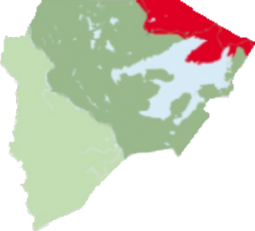
The arctic fox (Alopex lagopus) has a compact body with short legs, short ears, dense fur, and thickly haired foot pads which provide traction on the ice as well as protection from the cold. The average height of an adult male is 25-30 cm at the shoulder, with the female being slightly smaller. The adult male fox weighs about 3-4 kg. Like many arctic animals, the arctic fox changes colour with the seasons to stay camouflaged. In the winter, their coat turns to a brilliant white, although some may have blue-grey patches, while in the summer it turns brown.
Lynx
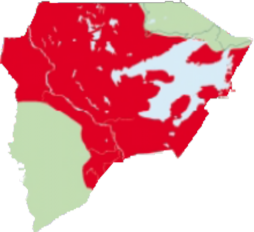
The lynx (Lynx canadensis) is the only wild felid found in the boreal forests of the Northwest Territories. It is a medium-sized animal (10 kg for males and 8.5 kg for females) set on solid legs, those at the rear noticeably longer than the front, with large paws, a fairly small head, and a very short tail. The coat is long and thick with distinctive tufts on the ear tips. Long fur on the feet aids movement over soft snow. “Sideboards” become especially noticeable in winter, and may develop to a nearly full ruff. Its colour ranges from grey to brown.
Lynx can climb well and are good swimmers. They have acute vision and will stalk prey over long distances or wait patiently in ambush before making a final, typical cat-like bound from as close as possible. They are usually solitary animals and nocturnal hunters, but cooperative hunting has occasionally been observed, with rabbits being driven towards a waiting ambush, or a pair of lynx stalking from both sides of joint prey.
Marten
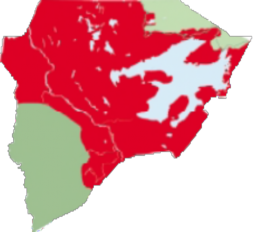
The marten (Martes americana) is found within the boreal forest of the Northwest Territories. It is a mediumsized member of the weasel (Mustelidae) family, and is closely related to fishers, badgers and weasels.
Martens that are found in the Northwest Territories are larger than those found further south. They are about the size of a house cat, with the adult male weighing about 1.5 kg, and measuring about 75 cm in length. The adult female is about three-fourths the size of the male.
The fur of the marten is soft and thick, varying in color from yellowish-brown to reddish or dark brown. The martens' throats are pale buff; their tails and legs are black. Two vertical black lines run above the inner corners of their eyes. In winter, long hairs grow between the toe pads on the martens' feet. These keep the feet warm and enable them to travel on snow.
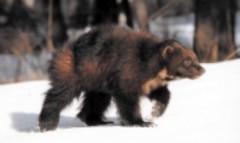
wolverine
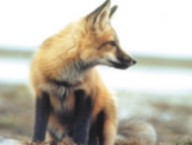
red fox
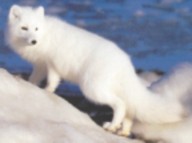
arctic fox
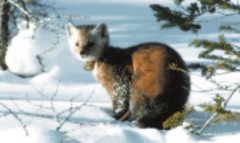
marten
[ Sahtu Atlas Table of Contents ]
[ Next Section ]
Fish
Fish of the Sahtu
The freshwater fish inhabiting the waters of the Sahtu have unique and diverse histories. Many species now in this area survived under harsh conditions in northern portions of unglaciated Alaska during the last ice age (ending about 10,000 years ago) while the majority survived in southern areas of the United States.
Fish are cold-blooded creatures, typically with scaly bodies and paired fins, that breathe by means of gills. Fish are excellent indicators of water quality and the presence or absence of certain species can provide immediate clues as to the conditions within a given area. Contaminant studies reveal further information about the aquatic environment. Due to the wide consumption of fish in the Sahtu, contaminant studies on several fish species are done to monitor environmental and public health.
Fishing remains one of the most important cultural and social activities for the people of the Sahtu. While wildlife may be absent from some areas during certain portions of the year, some fish species always remain accessible and thus have played a major role in the well being of the original inhabitants. World-renowned recreational angling by residents and visitors (a 33 kg Lake Trout was caught in Great Bear Lake in 2001) further reinforce the benefits and need for strong, sustainable fisheries, resource management and research.

Mackienzie River 'Coney', Fort Good Hope © Robert Kershaw
Bodo and the Big Fish Told by Peter Baton, Deline Elder
My Grandmother told me this story of Bodo and the Giant Fish, She says once the fish in Mackintosh Bay go bad they disappear. That is what happened one time, so we had a hard time.
Bodo went to check his hooks by knife point. He only caught a very skinny fish. He then thought to himself that other people might be using medicine to keep the animals away, so catching this little fish made him angry because there are people and dogs to feed and they are not catching any animals. He put his hook back in the water and caught a fish, but the hole was too small, so he had to use his knife to make the hole bigger. He then got the fish out. It was so big that he had to cut it up and bring some home. My Grandmother said Bodo told them to get two dogs and go to the hooks and pick up the rest of the fish. My granny says that the trout was so big that it had horns about the size of a thumb and the guts were out in a separate pile for the dogs. It was just fat.
That is what my granny has told me about Bodo and the Giant Fish.
Residents of Fort Good Hope have long relied on fish from the Mackenzie River as a source of food for themselves and their dogs. Accelerated oil and gas development in the Mackenzie Delta has many people concerned about possible negative impacts on the fisheries resource. As the fisheries resource is perhaps one of the most valuable of all renewable resources in the Mackenzie Delta and the one most likely to be negatively impacted by oil and gas development, it is one that should be monitored for changes.
From the Department of Oceans and Fisheries/Sahtu Renewable Resources Index Netting Study

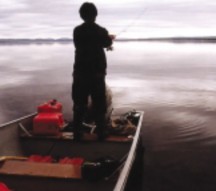
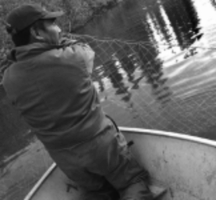
Photos top to bottom
Ice fishing on Great Bear Lake © George Tackazo
Mackienzie River fish camp © Robert Kershaw
Matthew Perriot, Loche Lake © Robert Kershaw
Jeffery Jackson checking net © Robert Kershaw
Key Fish Species In The Sahtu
Arctic Grayling / T’áe
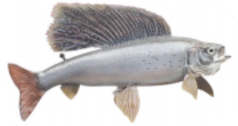
The arctic grayling is a beautiful fish: dark blue on the back and purple grey on the sides. A distinctive characteristic is its large, sail-like dorsal fin, which is coloured a blackish blue with violet spots. Average weights are from 0.5 to 1 kg (1 to 2 lbs.), but the world record arctic grayling was caught in the Great Bear Lake area and weighed 2.7 kg (6 lbs.).
In the Sahtu, the grayling is particularly common in the Mackenzie, Great Bear and Anderson drainages. During the summer, they can be caught in cold, swift rivers and in bays of some larger lakes.
Lake Trout / Sahba
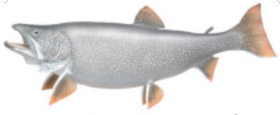
Lake trout are coloured with light spots on a darker background and a light-coloured belly. The background colour may vary from light green or grey to dark green, brown or black.
The lake trout is found throughout the Mackenzie drainage systems. Although most angling has occurred on Great Bear Lake, "lakers" are plentiful and provide spectacular sport in hundreds of fastflowing rivers and streams. The best trophy recorded was a world record catch from Great Bear Lake weighing 33 kg (74 lbs). Many others have come close to this, and 13 to 18 kg (30 to 40 lbs.) fish are common.
Jackfish (Pike) / Ɂǫ́hda

Pike, or jackfish, prefer warm, slow, heavily-vegetated rivers, or shallow, warm, weedy bays of lakes. They occur throughout most of mainland Northwest Territories. They have a long body with a dark green to brown colour along their back. The sides are lighter and marked with 7 to 9 irregular vertical rows of yellow to white, bean-shaped spots. Pike generally run between 2 and 7 kg (5 to 15 lbs.), but many pike weighing 13 to 18 kg (30 to 40 lbs.) have been taken
Lake Whitefish/ Luge wá

The lake, or humpback, whitefish occurs mainly in lakes, although some are taken in larger rivers and some in lakes with brackish waters. It is a large and somewhat egg-shaped fish with silver sides that may shade to dark or olive brown. The snout overhangs the lower jaw and has two flaps between the openings of each nostril.
The whitefish is mainly a bottom feeder, eating freshwater clams, snails, insects and invertebrates. Some may feed on plankton. Spawning takes place in the fall on rocky reefs in lakes or the shallows of rivers.
Walleye / ɂéhch’ı̨́ą
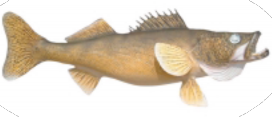
The walleye is a member of the perch family and has sharp teeth and two dorsal fins on its back, the front one supported by large spines. Walleye are olive-brown flecked with gold, shading to a white belly. The large, silvery eyes are distinctive.
Also known as doré or pickerel, walleye are plentiful in smaller lakes to the south, but are less common in the Sahtu.
Walleye generally run up to 2.5 kg (5 lbs.). They are easiest to fish in the spring when they are running in the rivers
Inconnu / Sıh
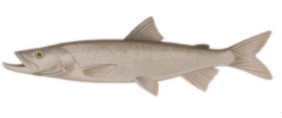
Fur trade voyageurs gave this "unknown" fish its name. Locally called Coney, it is a member of the whitefish family. With large scales, dark back, silvery sides, and deeply forked tail fin, it resembles a large herring. Still unknown to many anglers, it is found in the tributaries throughout the Mackenzie River Valley. Weights can average 4-9 kg (9-20 lbs) although some have been reported over 32 kg (70 lbs).
[ Sahtu Atlas Table of Contents ]
[ Next Section ]
Wolves
Wolves, Canus lupus are a member of the dog, Canidae family. Adult males average about 35 - 40 kg, while females are smaller, at about 30 - 35 kg. Length of males, from nose to the tip of the tail, varies from 1.5 to 2.0 m, with females from 1.4 to 1.8 m.
Wolf coat colour varies from pure white to black, with accompanying shades of cream and brown. The most common colour is grey. The wolf's coat is thick; composed of long, coarse guard hairs and short, soft underfur. In the Northwest Territories, the coat moults only once, in late spring. By winter, the short, new pelage grows into a silky coat with the underfur appearing in autumn.
Distribution
In the Northwest Territories, two different groups of wolves can be distinguished based on behaviour and distribution. Wolves that live below the treeline or in the mountains are commonly known as timber wolves. They depend mostly on non-migratory prey like moose. Wolves that travel above and below the treeline on the mainland of the Northwest Territories are commonly known as tundra or caribou wolves. They depend largely on barrenground caribou and do not maintain regular territories
Behaviour
Howling may be a wolf's message to pack members of its whereabouts. Ahowl may summon pack members to a nightly hunt or adults may howl to find a lost pup. It may also be that wolves simply enjoy howling, alone or in groups. People who have observed group howls attest to the wolves' obvious pleasure in the occasion and to the marvelous sounds of the wolf voices in harmony.
Throughout the winter, wolf packs travel many kilometres, feeding where they find prey and resting when they are tired, or when extreme temperatures and storms cause them to seek refuge. Winter travel routes include game trails, ridges, seismic lines and frozen waterways. In deep, fluffy snow, wolves find traveling difficult and will often use roads or snowmobile trails to ease movement.
Wolves accompany nearly all caribou herds most of the year. Under most circumstances a caribou can easily outrun a wolf. However, in most cases, wolves simply chase a large herd of caribou, on the alert for any animal caught off guard, that stumbles or appears weak. Old and ailing caribou, or a calf which hesitates a second too long, are often victims.
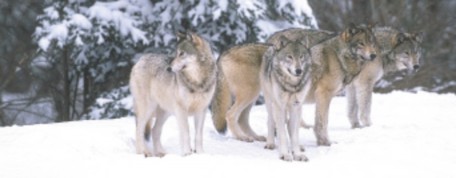
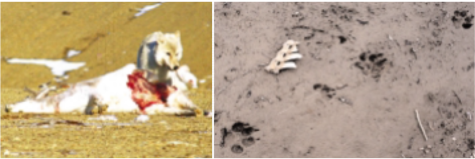
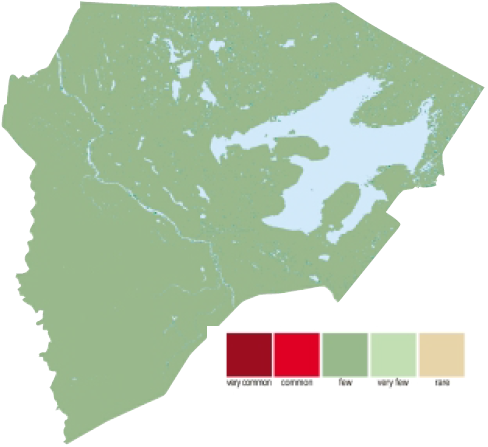
The Fate Of Caribou/ Éfę́ Gulí
told by William Sewi
© Alfred Masuzumi
Here's a good story. Long ago, when the wildlife were new, Ékwę́ and Dígaı (wolf) met out on the barrengrounds, north of Aklavik. The leaders of both groups were old.
The old Dígaı leader said, “Ékwę́ should be wiped off the face of the earth.” They were all sitting face to face, and no one said anything for awhile. Finally, old Ékwę́ asked, "What's the misunderstanding? Why don't you simply tell us what you don't like about us?"
Then Dígaı said, "The purpose of this meeting is to wipe you from the face of the earth."
Ékwę́ asked, "What wrong are we accused of? All we look for is food for our survival. And the humans are surviving from us. In the future, people will depend on us for their food.
You, Dígaı, are not like that. You are a conniving animal, and we predict that in the future you will kill humans. There will be packs of you attacking and killing humans. And you will also be killing us. This is how you will survive. You'll kill moose, and every other animal.
"You are a sly animal. When human kills game for his survival and covers it for safekeeping, you will steal his food. And when he's out trapping, you'll go along his trapline and take out the bait. That is how you will be spending your time. Yes, this is how you will be in the future.
"We Ékwę́, we are the good wildlife. We are on the earth only to look for our food. We can never disrupt anything in nature. This is our destiny until the end of the world.
"Whatever people eat, it becomes their flesh and blood. This can never be taken away from man.
"Yes, in the future people will be surviving on us for food, and you will also.
And then Dígaı got up and said, "Yes, Ékwę́ speaks the truth. What he says of the future is true. And I believe him."
And so Ékwę́ won, and old Dígai was over-ruled.
Ékwę́ said, "Henceforth until the end of the world you will survive off of us. There'll be no need to bring this matter up ever again. And so, this meeting is over."
Originally published in the Mackenzie Valley Viewer, March 2001. Printed with permission.
[ Sahtu Atlas Table of Contents ]
[ Next Section ]
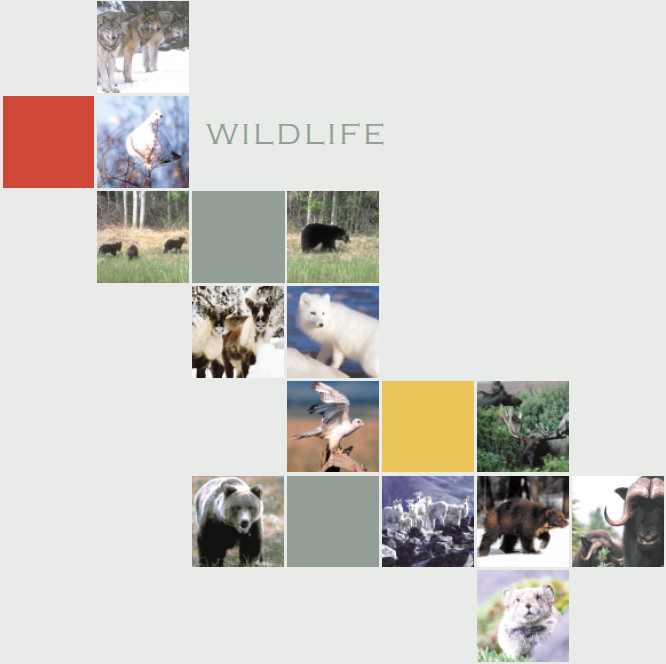












































 Phone: 867-374-4040
Phone: 867-374-4040 Email:
Email: